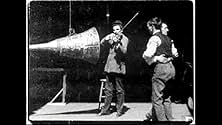It was on a day in 1891 when Scottish inventor William K.L. Dickson surprised his boss, Thomas Alva Edison with his remarkable work in the development of motion pictures. After many experiments, Dickson was now able to capture scenes of real life with his camera, and reproduce them through his invention, the Kinetoscope, as if a fragment of time were preserved in celluloid. Soon, Dickson's Kinetoscope would become an enormous success as a new way of entertainment, with many people eager to pay the nickel that was charged to be able to watch people dancing, or acrobats performing stunts through the "peepshow" of the Kinetoscope. However, the invention wasn't complete, in order for it to capture on film the real life as we know it, sound was needed on the movies. So Dickson kept experimenting and this short experiment, Kinetophone's first film, was the result.
In this experiment, codenamed simply as "Dickson Experimental Sound Film", director William K.L. Dickson stands in front of a recording cone for a wax cylinder (earliest method of recording sound), with his violin on hands, playing a song named "Song of the Cabin Boy". The idea was to record the song into the cylinder at the same time that the camera was recording his movements. In order to show that this was a motion picture, two of Edison's "Black Maria" laboratory decided to do a little dance in front of the camera. Unlike what author Vito Russo claimed in his book, "The Celluloid Closet", this little dance had nothing to do with homosexuality as it obviously is a reference to the environment of loneliness of the lab, akin to the lonely sailors to whom the "Song of the Cabin Boy" was dedicated to (the title Russo suggests, "The Gay Brothers", is actually anachronistic as "gay" had no homosexual connotation in the late 1890s).
Sadly, Dickson was unable to achieve the desired effect, and the Kinetophone never could really produce the synchronized audio with images. While he had the cylinder with the sound and the celluloid with the images, the synchronization of the two elements was not exactly effective, and the sudden appearance of Auguste and Louis Lumière's Cinématographe prompted Edison's team to focus on projecting systems and eventually Dickson left the company. Fortunately, in 1998 Dickson's cylinder with the movie's sound was rebuilt and film editor Walter Murch made a restoration of the experiment as it was intended. Finally, "Dickson Experimental Sound Film" could be heard with synchronized sound, just as its creative inventor had intended. While it was not a successful attempt, this outstanding film is a testament of the enormous genius of the father of Kinetoscope. 8/10















